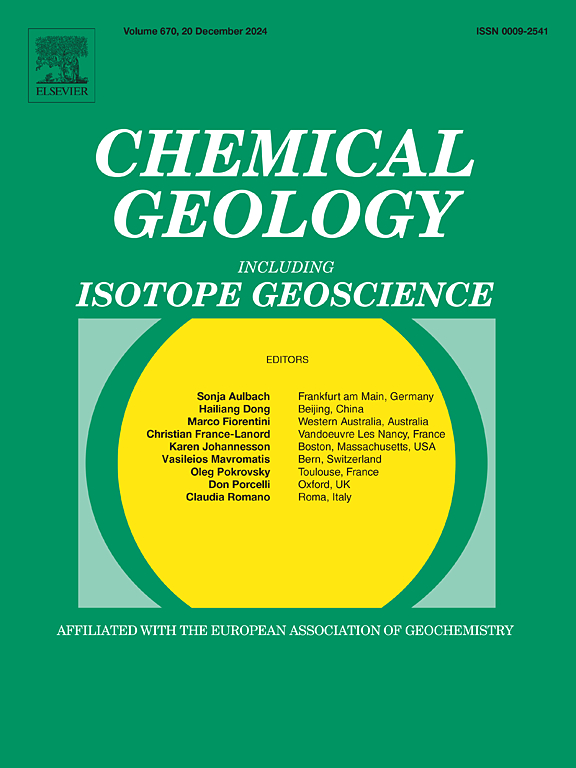Microbial sulfate reduction regulated by relative sea level change in a Pleistocene – Holocene sedimentary record: Insights from Loch Duart, Scotland, UK
IF 3.6
2区 地球科学
Q1 GEOCHEMISTRY & GEOPHYSICS
引用次数: 0
Abstract
A Pleistocene–Holocene-aged sediment core recovered near Loch Duart, located in the coastal Assynt region of NW Scotland, UK, provides new insight into the relationship between the sulfur isotope composition of iron sulfides (pyrite) and organic sulfur under rapidly changing environmental conditions. Since the Late Glacial period, shifts in local marine connectivity at Loch Duart have been driven by the competition between two fundamental Earth surface processes: eustatic sea level rise due to post-glacial meltwater contributions since the Last Glacial Maximum and relative sea level (RSL) fall associated with glacial isostatic rebound. These processes, imprinted on the sedimentary record, have been evaluated via lithology, microfossil assemblages, elemental analysis, and isotopic measurements. Over the last 17 kyr, Loch Duart has transitioned from (1) marine conditions, when eustatic rise due to deglaciation exceeded glacial isostatic rebound, to (2) non-marine conditions, where land uplift caused by isostatic rebound exceeded eustatic rise, to (3) marine conditions, as the eustatic contribution outpaced isostatic rebound, followed by (4) brackish-water conditions, as the eustatic contribution reduced while glacial isostatic uplift continued, with marine inundation limited to part of the tidal cycle at the present day.
Here, we evaluate marked perturbations in the local sulfur (S) cycle related to the aforementioned environmental changes. The marine interval coincides with relatively stable and low δ34Ssulfide values (average ∼ −27.2 ‰), the non-marine interval records an abrupt positive δ34Ssulfide excursion of over 30 ‰ (average ∼ 9 ‰), and the brackish interval preserves intermediate values (average ∼ −16.2 ‰). The δ34Sorg values shift sympathetically with δ34Ssulfide, although the magnitude of δ34Sorg change is nominal by comparison, particularly during the transition from freshwater to marine facies. As expected, marine and brackish sections preserve higher δ34Sorg values than coeval δ34Ssulfide. Interestingly, this relationship is reversed in the freshwater facies, where sulfides are 34S-enriched relative to organic S by as much as 20 ‰, suggesting that RSL modulates the isotopic composition of non-pyrite phases in the bulk S pool. We hypothesize that this inverse relationship (δ34Sorg < δ34Ssulfide) may arise from a spatial decoupling of pyrite and organic S formation within the water column and/or sediments in a system with low sulfate concentrations. Evaluating shifts in the local S-cycle associated with RSL changes allows for a novel comparison between S and osmium isotope records, demonstrating that these proxies may have joint applications for paleoenvironmental investigations in shallow coastal systems. We offer new perspectives on the interplay between eustasy, RSL, and the S-cycle by assessing these relationships in a coastal isolation basin.
求助全文
约1分钟内获得全文
求助全文
来源期刊

Chemical Geology
地学-地球化学与地球物理
CiteScore
7.20
自引率
10.30%
发文量
374
审稿时长
3.6 months
期刊介绍:
Chemical Geology is an international journal that publishes original research papers on isotopic and elemental geochemistry, geochronology and cosmochemistry.
The Journal focuses on chemical processes in igneous, metamorphic, and sedimentary petrology, low- and high-temperature aqueous solutions, biogeochemistry, the environment and cosmochemistry.
Papers that are field, experimentally, or computationally based are appropriate if they are of broad international interest. The Journal generally does not publish papers that are primarily of regional or local interest, or which are primarily focused on remediation and applied geochemistry.
The Journal also welcomes innovative papers dealing with significant analytical advances that are of wide interest in the community and extend significantly beyond the scope of what would be included in the methods section of a standard research paper.
 求助内容:
求助内容: 应助结果提醒方式:
应助结果提醒方式:


